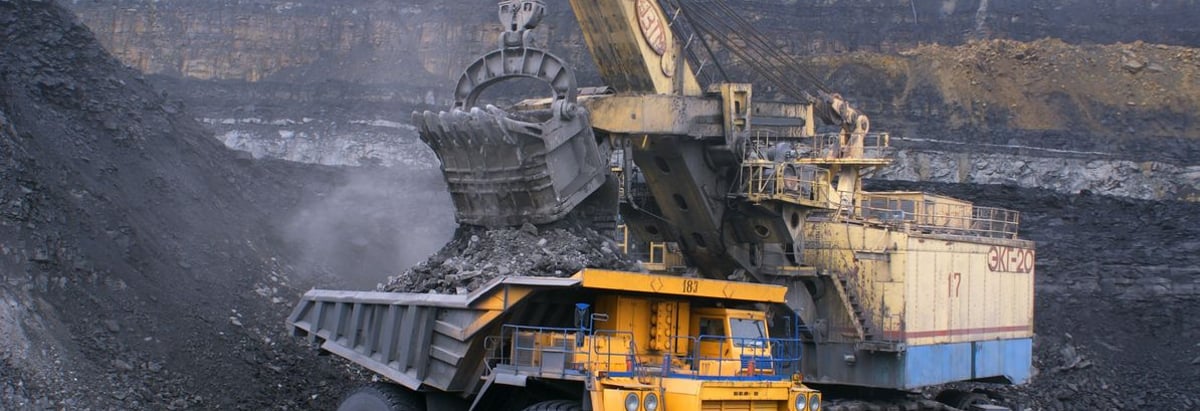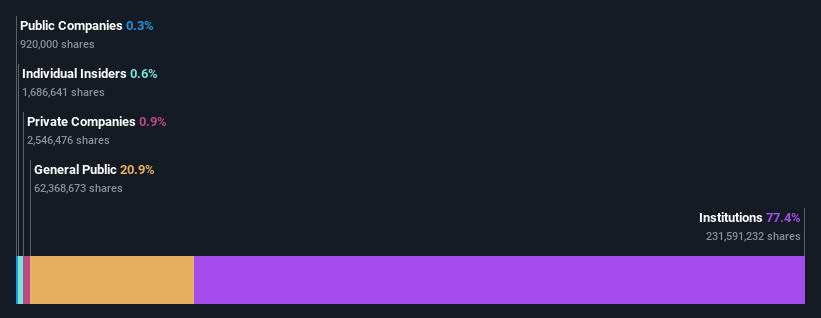- Australia
- /
- Oil and Gas
- /
- ASX:PDN
Following a 23% decline over last year, recent gains may please Paladin Energy Ltd (ASX:PDN) institutional owners

Key Insights
- Institutions' substantial holdings in Paladin Energy implies that they have significant influence over the company's share price
- A total of 8 investors have a majority stake in the company with 53% ownership
- Analyst forecasts along with ownership data serve to give a strong idea about prospects for a business
Every investor in Paladin Energy Ltd (ASX:PDN) should be aware of the most powerful shareholder groups. The group holding the most number of shares in the company, around 77% to be precise, is institutions. In other words, the group stands to gain the most (or lose the most) from their investment into the company.
Last week's AU$120m market cap gain would probably be appreciated by institutional investors, especially after a year of 23% losses.
In the chart below, we zoom in on the different ownership groups of Paladin Energy.
See our latest analysis for Paladin Energy

What Does The Institutional Ownership Tell Us About Paladin Energy?
Institutions typically measure themselves against a benchmark when reporting to their own investors, so they often become more enthusiastic about a stock once it's included in a major index. We would expect most companies to have some institutions on the register, especially if they are growing.
Paladin Energy already has institutions on the share registry. Indeed, they own a respectable stake in the company. This can indicate that the company has a certain degree of credibility in the investment community. However, it is best to be wary of relying on the supposed validation that comes with institutional investors. They too, get it wrong sometimes. It is not uncommon to see a big share price drop if two large institutional investors try to sell out of a stock at the same time. So it is worth checking the past earnings trajectory of Paladin Energy, (below). Of course, keep in mind that there are other factors to consider, too.

Institutional investors own over 50% of the company, so together than can probably strongly influence board decisions. Paladin Energy is not owned by hedge funds. The company's largest shareholder is State Street Global Advisors, Inc., with ownership of 11%. With 9.8% and 6.6% of the shares outstanding respectively, FMR LLC and Mirae Asset Global Investments Co., Ltd. are the second and third largest shareholders.
We did some more digging and found that 8 of the top shareholders account for roughly 53% of the register, implying that along with larger shareholders, there are a few smaller shareholders, thereby balancing out each others interests somewhat.
Researching institutional ownership is a good way to gauge and filter a stock's expected performance. The same can be achieved by studying analyst sentiments. There are a reasonable number of analysts covering the stock, so it might be useful to find out their aggregate view on the future.
Insider Ownership Of Paladin Energy
While the precise definition of an insider can be subjective, almost everyone considers board members to be insiders. Company management run the business, but the CEO will answer to the board, even if he or she is a member of it.
I generally consider insider ownership to be a good thing. However, on some occasions it makes it more difficult for other shareholders to hold the board accountable for decisions.
Our most recent data indicates that insiders own less than 1% of Paladin Energy Ltd. It's a big company, so even a small proportional interest can create alignment between the board and shareholders. In this case insiders own AU$13m worth of shares. It is always good to see at least some insider ownership, but it might be worth checking if those insiders have been selling.
General Public Ownership
With a 21% ownership, the general public, mostly comprising of individual investors, have some degree of sway over Paladin Energy. This size of ownership, while considerable, may not be enough to change company policy if the decision is not in sync with other large shareholders.
Next Steps:
While it is well worth considering the different groups that own a company, there are other factors that are even more important. For instance, we've identified 3 warning signs for Paladin Energy (2 can't be ignored) that you should be aware of.
If you would prefer discover what analysts are predicting in terms of future growth, do not miss this free report on analyst forecasts.
NB: Figures in this article are calculated using data from the last twelve months, which refer to the 12-month period ending on the last date of the month the financial statement is dated. This may not be consistent with full year annual report figures.
New: Manage All Your Stock Portfolios in One Place
We've created the ultimate portfolio companion for stock investors, and it's free.
• Connect an unlimited number of Portfolios and see your total in one currency
• Be alerted to new Warning Signs or Risks via email or mobile
• Track the Fair Value of your stocks
Have feedback on this article? Concerned about the content? Get in touch with us directly. Alternatively, email editorial-team (at) simplywallst.com.
This article by Simply Wall St is general in nature. We provide commentary based on historical data and analyst forecasts only using an unbiased methodology and our articles are not intended to be financial advice. It does not constitute a recommendation to buy or sell any stock, and does not take account of your objectives, or your financial situation. We aim to bring you long-term focused analysis driven by fundamental data. Note that our analysis may not factor in the latest price-sensitive company announcements or qualitative material. Simply Wall St has no position in any stocks mentioned.
About ASX:PDN
Paladin Energy
Engages in the development, exploration, evaluation, and operation of uranium mines in Australia, Canada, and Namibia.
High growth potential with adequate balance sheet.
Similar Companies
Market Insights
Community Narratives



